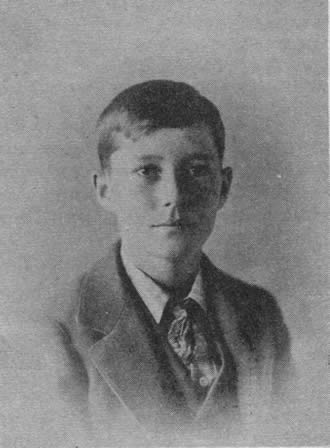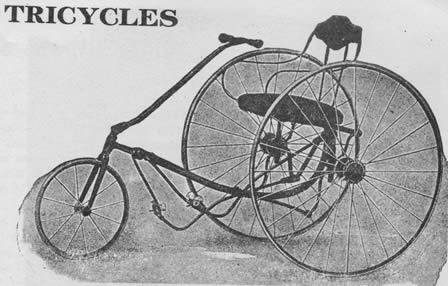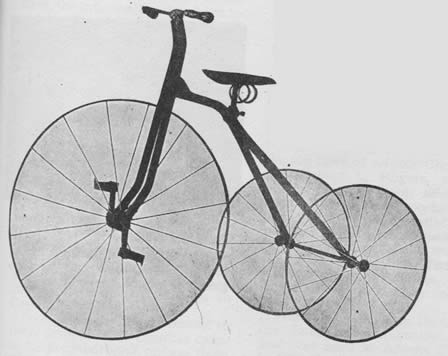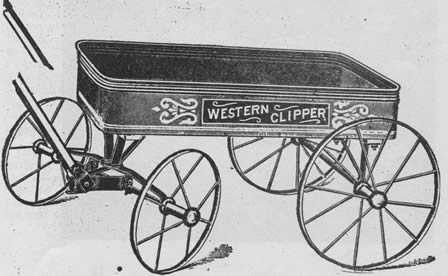Volume 1, Number 5 - Fall 1962
Games and
Toys at the Turn of the Century
Dolls, Flying Jennys
and Circle-Four-To-Rowser
Whether your childhood was just yesterday or many years ago, these reminiscences of men and women of the White River Valley are guaranteed to stir memories of that childhood - the favorite toy that was all-important for a time, or the half-forgotten games whose rules you once knew so well. You may even be tempted for a moment to try your hand at making a "Flying Jenny."
When Mr. Frank Logan (now past eighty) of south Carroll County, Arkansas, was a youngster, most of the toys, from whistles to merry-go-rounds, were made at home. The boys made whips using hickory growths to braid or they might dig long runner mulberry roots. If it was to be a three-strand braid, the bark was split for three back to about eight inches of the limb or root and then braided. Some of them also learned four-strand braiding. In order to make these bark whips and whistles, the sap must be up and the bark must be kept moist. The whips were useful for driving cattle, but the boys enjoyed just practicing popping the "cracker" or tip end of the whip.
The older boys made a flying jenny or merry-go-round. This was done by cutting down a small tree, leaving the stump about three feet high with a pivot on top. For the "go-round" part, a long pole was used. In the center a hole was made with auger and chisel, so they might take a wedge and split the timber to go on the pivot. It took a good-sized timber to hold up a boy or two on each end. Then, of course, two or three boys worked on the inside to furnish the power for the flying jenny.
Small children had the teeter- totter. To make it, they put the board or timber through a rail fence or across a backlog in the woodyard. Other toys they made were sleds, bows and arrows, truck wagons, and puzzles of wood and metal.
The girls made most of their dolls, but sometimes received one that was "store-bought." They might expect a few other toys from the store: dishes, lamps, slates and a few books. The boy who could afford a good pocket knife was up in higher society, but marbles were common to most boys.
Mr. Logan says that when his father went to town, he would ask him and his brother what they wanted. Frank would always want a rope. He says that a rope or a large wrapping cord was enough to satisfy him.
For quiet games, checkers, fox- and-geese and dominoes were played. Outside games were ante- over, hide - and - seek, drop-the- handkerchief, stink base, wrestling, and "Old Sow." Old Sow was played by driving a ball or tin can, and each player had a hole and a club. The driver would try to drive the ball or tin can into a hole. He would quit driving if he could find an empty hole which didn't have the club of some other player in it. They also pitched horseshoes and took part in shooting matches.
Many of the pasttimes were enjoyed by the whole family: making molasses candy, popcorn balls, cider and maple syrup, telling riddles and stories. "Singings" were common in the homes, especially after the parlor organs became popular. For the music parties there would be those who could play the violin or fiddle, the banjo, mandolin and guitar.
In addition there were square dances and play parties. Mr. Ellis Bradley of Berryville says he and his sister enjoyed attending the dances. "Many times have I gone to the dances," he remembers, "and when I got close and could hear the music, I could hardly wait to tie my horse and get on the dancing floor." He says that while many people frowned upon dancing, to most people it was a good social pasttime. Later, when some of the young men started drinking at the dances, Mr. Bradley stopped attending them.
During the summer, the creeks and rivers furnished the men and boys a place to go swimming and fishing. Mr. Logan says that when he lived south of Berryville near Osage Creek, it was a common thing to catch eel when they were seining for fish.
High jumping and broad jumping were practiced by the boys, and the men sometimes joined them in mumblepeg. Foot races were mostly for the boys, but sometimes girls would run and it was a little embarrassing when one of them outran a boy.
Mr. Lynn Tunnell of Ozark says;
"I was born in Ozark, Missouri, 79 years ago when it was a village of about 500 people. I have lived here all my life. My father, John L. Tunnell, operated a drug store on the north side of the Public Square. We were not rich; neither were we poor, but for some reason Christmas as a time for gift-giving was not observed in our family, and I do not remember having any toys of my own. I do remember, however, how glad I was to visit a nearby friend. He had received a rocking horse for Christmas and would let me ride it.
"At about the age of 10 (when the accompanying picture was taken), I began selling the St. Louis daily papers on the street. Thereafter I bought my own clothing and saved up $25 with which I bought a real pony.
"Although quite busy, I still had time for the many games we
[13]
youngsters played. At school these were: shinny (using a battered tin can), ante over, mumblety peg, crack the whip, marbles, and run-sheep-run. There was a mixed game, also, called "Snap." It was something like drop-the-handkerchief. I recall one time when we were all standing in a circle and my next-door neighbor, a girl somewhat older than I, snapped her fingers behind me. That meant I was supposed to kiss her. But she reneged and started to run away. I caught and held her and got my kiss any way.

Ten-year-old Lynn Tunnell, Ozark, Mo., 1893.
"Party games we played included wolf-over-the-hill, though I can't recall the details of how it was played, postoffice, and a dancing game called "Circle-four to-rowser." In this parlor game we paired off, boy and girl, and sashayed around to music much as in a square dance. We would all join hands, move in and out in a circle, then exchange partners as the dance proceeded.
"In winter our chief Sunday afternoon diversion was making popcorn balls with molasses at various homes. If the Finley River mill-pond was frozen over, as it often was, we went skating.
"It was a time when ice was cut and stored in an old livery stable across the street from the present Christian Church. The abandoned horse stalls were filled with corncobs. On bad days we boys would sneak in there and have vigorous cob fights, dodging in and out of the stalls."
In remembering her childhood, Mrs. Ella Dunn of Walnut Shade, Missouri, writes, "At Christmas time the little girls In my day were all hoping they would be looked upon with favor when Santa came by and he would leave them a "store doll." We didn't have betsy-wetsy or bride dolls, but just those spindly-legged little china dolls with painted hair. Most of us were lucky to get a rag doll stuffed with lambswool. Many of the boys whittled their own guns from a piece of soft wood. They got a knife now and then, but the metal was usually so soft they spent most of their time whetting them. They would construct farms using the knives to whittle all the different animals out of corn stalks and building their fences of the same. The houses usually were made of corn cobs. They had robber gangs and some little outlaw rancher would slip in and steal another's horses or cattle. Then the stick guns would come into play."
Mr. J. T. Sisk of Berryville was born in 1883 near what is now Cherokee Village, Hardy, Arkansas. He grew up on the family homestead in Stone County, two miles east of Blue Eye. Asked about his favorite pasttimes, he said,
"The first toy that I remember was a wagon, a homemade one. To make it, you would take a good round log and saw off wheels from it and then make a bed and axle. The truth is I didn't have very many toys. One game I liked to play was hitting a ball with a broomstick. Mother would ravel up old socks and make the ball and then I could knock it pretty far with a broomstick for a bat. One pet I had was also my transportation, "Old Pete," a mule I used to ride to Oak Grove when I was eight years old. I went to school at the old Scott school which was a log house with a fireplace and split log seats. There we played ball and marbles ("rolley hole" was one of my favorites - there would be holes gouged in the ground and the marbles had to go in a certain way, something like croquet).
Sometimes we would play drop-the-handkerchief with the girls, and pop-the-whip. I guess my favorite pasttime was to cut elder bushes and make pop guns (we shot spit balls out of them), and I liked to make whistles out of hickory."
Mrs. Mable Kentling Campbell of Highlandville tells of her childhood:
"I was born in Highlandville, Christian County, Missouri, late in the Nineteenth Century. I have always lived there and for the past forty-one years have been the town's postmaster, like my father and grandfather before me.
"As a child I did not have a great variety of toys, nothing like the children of today have. Of course, I always had a doll. This with its clothing, bed and card board house was my principal toy.
"At school several of us small girls would build a playhouse out of rocks. In this we placed our dolls and furnished it with bright pieces of broken china brought from home. I recall trading pieces of candy for such bright pieces brought to school by other girls. The boys would make their play houses out of sticks and leaves, and fashion play horses and guns out of cornstalks.
"My father, Frank Kentling, Jr., kept a store. At Christmas time he would have a shelf of toys on display which were put away as soon as the holiday was over.
"One of the poignant memories of my childhood is this: in Christmas week my father cut a cedar in the woods, set it up in the store and decorated it with colored baubles. Under the tree he ranged some of the toys he had for sale, although few of the families in our community could afford to buy their many youngsters toys, even though from today's standpoint they were comparatively in-expensive - 50 cents for a large teddy bear, for instance. I can still see the wistful faces of the children who stopped outside the store window and pressed their fore heads up against it for a long look at the splendors within. They knew they could not hope to have any toys.
"Another memory from childhood: My grandfather Kentling had several granddaughters near
[14]
my own age, nine at the time. He also had a large apple orchard. He enjoyed
playing this game with us: He would bring from the store a number of those round,
hard candies which were strung on a piece of cord like beads. He would hang
these from several trees throughout that big orchard, then stand back and chuckle
at our squeals of delight when we were turned loose and found them.
"At school our games were the old standbys: dare base, hop scotch, shinny,
blackman, and blindman's bluff. Our party games were chiefly skip-to-my Lou,
square dances and, of course, postoffice"
Those who interviewed the people quoted are: Mr. Coy Logan, Berryville, Arkansas; Mr. Woody Sisk, Shreveport, Louisiana; and Mr. Gene Geer, Ozark, Missouri. Mrs. Ella Dunn, Walnut Shade, Missouri, gave permission to use her newspaper column, "Here and There.")
TRICYCLES

A tricycle designed
for girls came in three sizes for ages 2 to 5 years. The hind wheels varied
from 18 to 20 inches in height. The prices were more than double the Boys Velocipedes:
$5.50 to $10.50 wholesale.
VELOCIPEDES

The Velocipede could
be bought for boys from 2 to 7 years of age. The height of the front wheel ranged
from 14 to 20 inches, with the smaller models having steel tires and the larger
models having rubber tires. Prices, wholesale, ranged from $2.40 to $5.00.
For the youngsters in the White River Valley at the turn of the century, the toys shown on this page may have been just pictures in a catalogue. The illustrations are of items sold by a Springfield, Missouri, hardware firm doing business in 1910 and are from a catalogue belonging to Mrs. Maxine Evans, Forsyth, Missouri

The Western Clipper, a popular wagon, was described by its dealers as "Bed made of Extra Heavy Steel, with Four Brace Rods Underneath. Enameled Blue or Green Outside and Red Inside. Nickeled Hub Caps. Heavy Gear and Wheels Enameled Black. Name printed in Gold. Bent Hardwood Handles, with Loop Hand Hold." Wholesale price for the smallest size, 12 x 24, was listed as $1.88 each, and for the largest size, 15 x 30, $2.58.
[15]
This volume: Next Article | Table of Contents | Other Issues
Other Volumes | Keyword Search | White River Valley Quarterly Home | Local History Home
Copyright © White River Valley Historical Quarterly

